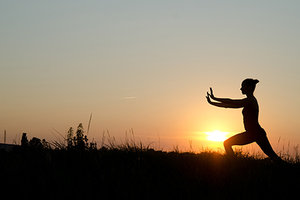Each morning for the past week, I have found myself to be a bit more tired than usual. There were nights when I went to bed a little late and nights I went to bed early, but it didn't make a difference. Some mornings I even felt a little tickle in my throat and others I noticed a slightly runny nose and little extra saliva in my mouth—well there's a reason.
This is the reason I prescribe the art and exercise of Tai Chi when the seasons change. Although there are numerous styles of this exercise, its overall gentle movements and calming nature provide one important element in this time of seasonal transition—movement.
Practicing Tai Chi
 A consistent Tai Chi practice during any seasonal transition, especially from summer to fall, will allow for a healthy experience of movement from one season to the next, no matter the type of climate. Whether you live in the northern or southern hemispheres, on the equator, or in Antarctica, there is always a transition in the environment, which has an inevitable effect on the body's physiology.
A consistent Tai Chi practice during any seasonal transition, especially from summer to fall, will allow for a healthy experience of movement from one season to the next, no matter the type of climate. Whether you live in the northern or southern hemispheres, on the equator, or in Antarctica, there is always a transition in the environment, which has an inevitable effect on the body's physiology.
The main reason why practicing during the summer to fall transition is so important is due to the overall nature of the seasons. During summer exists the peak temperatures of the year in the external environment, which create physiological changes that lead to the release of heat (sweating) from our bodies. Or it can lead to something we refer to as warm diseases (think heat exhaustion) because our bodies are unable to release the heat inside of us leading to dangerous and sometimes life-threatening conditions.
Additionally, as you may already be aware, there is a large amount of breathing occurring during the practice of Tai Chi. This breathing is a constant exchange of air and its contents between the external and internal environments which allow is to more rapidly create a level of balance between the two ultimately guided by a mindful approach to practice.
The Other Seasons
After summer, we transition towards the colder seasons, first moving through fall; a season of dryness, chilly temperatures, and less and less movement in the outdoors (e.g. the beginnings of hibernation). So, as you can see, if we live in these environments, then our bodies are certainly affected by them, and we must take appropriate action to adjust in parallel with them.
I believe Tai Chi to be the single most effective form of exercise that offers and guarantees (with your consistent practice and close observation of your physiological changes) the opportunity for a healthy transition through any season's change.
Justin Flinner is a Board-Certified and licensed acupuncturist in Washington D.C. and the CEO of My Metro Medicine. He has been on the faculty of both the Maryland University of Integrative Health (MUIH) and Virginia University of Oriental Medicine (VUOM) lecturing on various topics in Oriental medicine. Justin is a graduate of MUIH with a masters in acupuncture, and he received his Bachelor of Science degree in exercise and rehabilitative sciences from Slippery Rock University.
For more information please visit www.mymetromedicine.com or email him at
.



